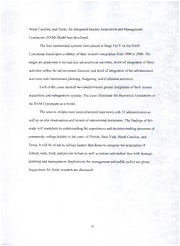
Toward an integrated system of income acquisition and management : four community college responses PDF
Preview Toward an integrated system of income acquisition and management : four community college responses
TOWARDANINTEGRATEDSYSTEMOF INCOMEACQUISITIONANDMANAGEMENT: FOURCOMMUNITYCOLLEGERESPONSES - By KATHRYNM.BIRMINGHAM ADISSERTATIONPRESENTEDTOTHEGRADUATESCHOOL OFTHEUNIVERSITYOFFLORIDAPNPARTIALFULFILLMENT OFTHEREQUIREMENTSFORTHEDEGREEOF DOCTOROFPHILOSOPHY UNIVERSITYOFFLORIDA 2002 ACKNOWLEDGMENTS Thisdissertationisdedicatedtomyhusband,GeraldT.Horton.Heismygreatest supporter,critic,andcoach.ThefullmeasureofmyappreciationgoestoJerryforhis commitmenttomeasafull-timedoctoralstudentoverthepast21/2years.Asanastute strategicplanner,helivestheancientChineseproverb,"Ifwedonotchangeour direction,wearelikelytoendwhereweareheaded."Ihopesomedaytomeethis scholarlystandards. Ithankmydaughters,Tina,Ellen,andAndi,fortheirpatienceandunderstanding whiletheirmotherwasengrossedinthisstudy.Asaqualitativeresearcher,certainly thesethreetaughtmeagreatdealaboutthetriangulationofdatatovalidateversionsofa story. Iwouldalsoliketothankmytwinsister,PegBirmingham,forhertremendous encouragement. Tomydissertationcommittee,Dr.DaleF.Campbell,Dr.DavidS.Honeyman, Dr.BarbaraJ.Keener,andDr.H.JohnHall,Iextendmyheartfeltgratitudefortheir guidance. Lastly,IamgratefulformyexperiencesatEisenhowerCollege.Myinterestin theincomeacquisitionandmanagementsystemsofcollegesbeganintheearly1980sata mostunusualprivateinstitution.Myhopeisthatthelifecycleofacollege,aschronicled byDr.DavidL.Dresser's1995casestudy,maynothavetobelearnedthehardway. u TABLEOFCONTENTS page ACKNOWLEDGMENTS ii ABSTRACT v CHAPTERS 1 BACKGROUNDOFTHESTUDY 1 Introduction 1 StatementoftheProblem 7 PurposeoftheStudy 8 StatementofIntent 11 GuidingResearchQuestions 12 SignificanceoftheStudy 13 DefinitionofTerms 15 ResearchDesign 17 Methods 17 Limitations 18 Assumptions 19 OrganizationoftheStudy 19 2 ACONTEXTFORENQUIRY 20 ChangesintheSourcesofRevenueforCommunityColleges 21 FundraisinginCommunityColleges 23 ResourceDevelopmentandInstitutionalPlanning 30 ChangingManagementActivities 38 IncomeAcquisitionandManagementasaSystem 39 Summary 45 3 RESEARCHMETHODOLOGY 47 ResearchProblem 47 PurposeoftheStudy 48 DesignoftheComparativeCaseStudy 50 ResearchMethods 53 Summary 59 111 4 FINDINGS 61 SelectionoftheColleges 61 ResearchMethodologyforIndividualCases 62 PresentationandAnalysisofDataforEachCase 62 CollegeA 63 CollegeB 85 CollegeC 104 CollegeD 122 Summary 146 5 CONCLUSIONS,SUMMARY,ANDRECOMMENDATIONS 147 ComparativeCaseConclusions 147 ModificationstoIIAMContinuumTheory 168 SummaryofFindings 171 ManagementImplications 172 PublicPolicyImplications 177 RecommendationsforFurtherStudy 178 ImplicationsforTheoryandPractice 180 APPENDICES A CRITERIAFORCOLLEGESINSTUDY 182 B KEYMANAGEMENTACTIVITIESASSOCIATEDWITH ADVANCEMENTFUNCTION 183 C CASESTUDYPROTOCOLS 184 D INTERVIEWGUIDES 188 REFERENCES 213 BIOGRAPHICALSKETCH 225 IV AbstractofDissertationPresentedtotheGraduateSchool oftheUniversityofFloridainPartialFulfillmentofthe RequirementsfortheDegreeofDoctorofPhilosophy TOWARDANINTEGRATEDSYSTEMOF INCOMEACQUISITIONANDMANAGEMENT: FOURCOMMUNITYCOLLEGERESPONSES By KathrynM.Birmingham May2002 Chair:Dr.DaleF.Campbell MajorDepartment:EducationalLeadership,Policy,andFoundations Highereducationliteraturedocumentschangesinthesourceoftherevenue streamforcommunitycollegesandstatesthatfundraisingandresourcedevelopment mustbecomealong-termcorefunctionofacommunitycollegeandmustbeintegrated withinstitutionalplanning,academicplanning,andmarketingactivities.Organizational structureandmanagementpracticesofhighereducationinstitutionschangeinresponse tochangesinthefundingenvironment. Theresearchproblemwas(a)toidentifyanddescribehoworganizational structureandmanagementactivitieshavechangedinfourcommunitycollegesin responsetothechangeinproportionalfundingofcollegeoperationsbythestate governmentand(b)todevelopandtestatheoreticalframework.Thecomparativecase studyexaminedtheadvancementactivitieswithintheincomeacquisitionand managementsystemsoffourcommunitycollegesinthestatesofFlorida,NewYork, NorthCarolina,andTexas.AnIntegratedIncomeAcquisitionandManagement Continuum(HAM)Modelwasdeveloped. ThefourinstitutionalsystemswereplacedatStageItoVontheIIAM Continuumbaseduponevidenceoftheirsystem'sintegrationfrom1996to2000.The stagesaregraduatedtoincludekeyadvancementactivities,levelsofintegrationofthose activitieswithintheadvancementfunction,andlevelofintegrationoftheadvancement activitieswithinstitutionalplanning,budgeting,andevaluationactivities. Eachofthecasesshowedmovementtowardgreaterintegrationoftheirincome acquisitionandmanagementsystems.Thecasesilluminatethetheoreticalfoundationsof theDAMContinuumasamodel. Thesourcesofdataweresemi-structuredinterviewswith33administratorsas wellason-siteobservationsandreviewofinstitutionaldocuments.Thefindingsofthis studywillcontributetounderstandingtheexperiencesanddecision-makingprocessesof communitycollegeleadersinthestatesofFlorida,NewYork,NorthCarolina,and Texas.Itwillbeofusetocollegeleadersthatdesiretointegratetheacquisitionof federal,state,local,andprivatedollarsaswellastuitionandstudentfeeswithstrategic planningandmanagement.Implicationsformanagementandpublicpolicyaregiven. Suggestionsforfutureresearcharediscussed. VI CHAPTER BACKGROUNDOFTH1ESTUDY Introduction Changesintherevenuestreamsofcommunitycollegesarewelldocumented.An EducationCommissionoftheStates(2000)studyfoundthatthemostseriousissues facingcommunitycollegesacrossthenationarethedualchallengesofincreasingstate andlocalfinancialsupportforcommunitycollegesandimprovingmethodsbywhichthe collegesarefunded.Increasinglythecollegesareseekingfundingsourcesotherthan staterevenues,localtaxation,andstudentfeesandtuition(Jenkins&Glass,1999).Over thepast20years,externalandinternalinfluenceshaveresultedincommunitycolleges movingfromtotalpublicsupporttolesspublicassistanceasapercentageofthetotal operatingbudget(Honeyman,Williams,&Wattenbarger,1991;Smith,1985). Amongtheexternalforcesaffectingthesourcesofincomeareeconomicchanges, risingcostsoflaborandtechnology,theimpactofdemographicsandimmigration,K-12 trends,publicpolicyresultinginlegislativecuts,andfinancialtrends.Internalevidences arefunddevelopmenttrends,theresponsetocompetitionandanewemphasison marketing,andstrategicmanagementpracticesandharddatashowingstudentoutcomes andsuccesses(Alfred,1996).Competitionforgovernmentfundinganddissatisfaction overthelevelofproductivityandperformanceofpublichighereducationinthe1990s gaverisetoperformancefunding(Richardson&delosSantos,2001). I 2 Anotherdocumentedexternalforceisshrinkingpublicresourcestosupport highereducationfromfederalbudgets(Townsend&Twombley,2001).Withcollege costsoutpacinginflation,grantsforstudentsdeclinedfrom49%to42%ofallfederalaid allocatedfrom1990to1996.Loansincreasedfrom48%to57%forallstudentsduring thisperiod.AlthoughthePellGrantremainsacriticalfoundationoffederalfinancialaid forcommunitycollegestudents,thepurchasingpowerofthePellGranthasfallen sharplyduringthe1990s,negativelyimpactingaccessandequity(Merisotis&Wolanin, 2000).ThemaximumPellGrantbuyslessthan30%oftheaveragetuition,roomand board,andfeesatpubliccolleges(Callan&Finney,1997). Communitycollegesthatinthe1980sand1990sreliedheavilyonfederalgrants, suchasFederalWork-Study,FederalSupplementalEducationalOpportunityGrants (SEOG),GEARUp,CarlD.Perkins(forTech-Prep),andCampusChildCare,are findingtheyarenolongerasplentiful,ifavailableatall(Merisotis&Wolanin,2000). ThegreatexceptionisNationalScienceFoundation(NSF)funding.NSFAwardsfor communitycollegeshaveremainedconstantataround$31.2millionannuallyfrom1995 through1999withajumpto$35millionin2000(V.Ross,NSFBudgetDivision, personalcommunication,September25,2001). Statefinancingofcommunitycollegeshasbeenimpactedbytheeliminationof remedialeducationin4-yearinstitutionsandpublicfinancialassistanceplansthataward onthebasisofmeritratherthanneed(Richardson&delosSantos,2001).Followingthe trendtoconcentrateremediationcoursesinthe2-yearsectorhighereducationalsystems, Florida,NewYork,andTexashavealreadybeguntodelivermostoralloftheirremedial classesinthe2-yearsector(Shaw,2001).Inaddition,theU.S.DepartmentofEducation 3 (1999)predictsthattherewillbeasteadyincreaseinenrollmentinpublic2-yearcolleges overthenextdecade. Inresponsetoeconomicpressures,publicpolicy,andlevelofappropriations,as wellasnewacademicandservicechallenges,collegeadministrationshavebecomemore focusedonfundraisingandbettermanagementpractices(Tierney,1998).Private foundations,individuals,andcorporatecharitablegiftsarereceivinggreaterattentionas newsourcesofincometoensurequalitypubliceducation(Banks&Mabry,1988; Keener,1982;Yee.1998).Decreasingpublicinvestmentineducationbythestate governmentscanstimulateprivatedevelopmenteffortsandinnovativefinancialaid solutions(Yee.1998).Between1992and1997,revenuefromprivategrants,gifts,and contractsincreasedby24%forcommunitycolleges.Thenumberofpublic2-year collegeswithendowmentsgrewbynearly40%between1992and1997(Phillippe& Patton,1999). Highereducationcompeteswithhealthcare,prison,policeservices,andother publicservicesforstatefinancialsupport.Communitycollegeshavelostgroundinthe competitionforstateresources,whileatthesametimebroadeningtheirmission (Breneman,1997).In1998,communitycollegeswereeducating43%ofthenation's undergraduatesforasmallshareofstateandfederalhighereducationmonies.Inthe 1980scommunitycollegesbecamemajorcompetitorsforstatetaxdollarswithmany stateappropriationsrangingfrom75%to90%ofthetotalexpendituresofthecolleges (Richardson&delosSantos,2001).However,by1992statefundsaccountedforonly 46%ofcommunitycollegerevenues,localsupportdroppedto18%,andstudenttuition andfeescovered20%.Federalandothersourcesmadeup16%oftheoperatingrevenues (EducationCommissionoftheStates,2000). TheWesternInterstateCommissionforHigherEducation[WICHE](1998)data giveamoredirepictureofoverallstateappropriationstohighereducationasa percentageoftaxrevenueinFigure1-1.Despitethefavorablebudgetaryenvironmentfor manystates,theU.S.rateofhighereducationappropriationstototalstateappropriations declinedfrom12%to9.7%from1992to1997. 13% 1992 1993 1994 1995 1996 1997 Year Source: AdaptedfromWesternInterstateCommission(WICHE)data, PolicyImplicationsforHigherEducation,1998 Figure1-1.StateHigherEducationAppropriations (Asa%oftaxrevenueforallstatesintheU.S.) MerisotisandWolanin(2000)suggestthatrevenuetrendsshowthatthefunding ofcommunitycollegeshasmigratedtowardamoreprivateandworkforce-oriented educationmodel. Thesignificantshiftinrevenuesourcestowardcontractedgovernmentandprivate programfundsfortraininghasbeenaccompaniedbyaparalleldeclinein operatingfundsfromstatetaxcoffers.Atthesametime,studentshavebeenasked topickupanincreasingproportionofthetab. (Merisotis&Wolanin,2000)
